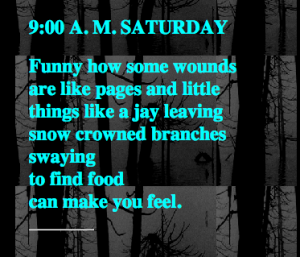i’m going back and forth in a triangle and then some kind of circle, flitting between tabs hoping for an opening up space for access to Isi-pîkiskwêwin-ayapihkêsîsak . access denied. this happens sometimes.
Ahasiw Maskegon-Iskwew produced this piece in 1996. how long ago was that? what age was the internet? remember that hilarious clip with katie couric? here is the mainstream media thinking about internet in 1994:
now i’m looking through the work of Loretta Todd. she says “the transformation that is a regular experience in native narratives is not like the experience of escapism in western narrative nor the disembodiment of cyberspace…”
escapism and disembodiment is what utopic sci-fi film The Cave, eviscerates, speaking as it does to a specific audience (not me) that has no need for tired narratives. it is aboriginal sovereign – process, collaboration, production. it is escapism disrupted since it’s escapism turning inward, towards home. but the mind trudge, the access-point searching continues.
now i am stopping over at the national film board website (how did i get here?) for a quick scan through Loretta Todd’s Hands of History, a 1994 documentary film that explores the inner lives of Doreen Jensen, Rena Point Bolton, Jane Ash Poitras and Joane Cardinal-Schubert, women who make art as a form of revival and resistance.
and then, again, i venture to wander through the portals that Ahasiw Maskegon-Iskwew leaves open. i know he leaves them open. for a moment, i’m caught in cold winter.

i’m cold and disoriented. the window is open. i pick up my notebook: 18/10/2015, i have scribbled “indigenous futurism” and exclamation-pointed “indigenous people are on the forefront of digital technology, pushing what new media is and can do.”
Ahasiw Maskegon-Iskwew’s work is raw. a few narrators, poetry, blinking icons. there is a circularity, not in the logical sense, but in the way you click on the buffalo and return home. as has been explained in other blogs, as well as in the artist’s statement, Isi-pîkiskwêwin-ayapihkêsîsak “concentrates on the experiences of people who have been consigned to the fringes of urban streetlife and their sources of joy, grief and intense humanity.” i see that in open and bare stanzas.
Now it don’t take much but it does take a
lot in a red light dream parade.
Cause like, some whacked out dude like,
picked her up, and her
initials are printed where she used
to walk and no one’s like, seen her
since.
But they had an open box anyway,
with pink paper. And steam rose
from the ground early that morning
with brown
and newspaper swirling,
pushed by barely unseen winds
in ghettos of grass.
each artist, some more than others, tells us of their love of Ahasiw Maskegon-Iskwew. his mentorship and vision.
Maskegon-Iskwew says, “The screenplay and storyboard are produced entirely on the World Wide Web in order to construct networks of relationships between the elements at each stage of development as a primary part of the work.”
this should be at the beginning but here it is: history converges with vision here. reaching back to 1996 when a man brought poets and visual artists and software developers together in a collaborative process to give voice to those “consigned to the fringes of urban streetlife.” those who may not ever really get on the internet in 1996 are rendered visible. the electronic form challenges Todd’s scepticism.
Todd asks:
“how do these concepts [of freedom of emotional singularity and community belonging] fit into cyberspace when cyber space has been created within societies that view creation and the universe so differently — one that creates hierarchies of being that reinforce separation and alienation with one that seeks harmony and balance with the self and the universe?”
Perhaps in the work of Ahasiw Maskegon-Iskwew, we find possibility.
Sources:
Vancouver’s Media World, Introduction
Narratives in Cyberspace, Loretta Todd
http://lovingthespider.net/?page_id=177
https://www.nfb.ca/film/hands_of_history
http://ghostkeeper.gruntarchives.org/essay-performing-transformations-ahasiw-maskegon-iskwew-sara-diamond.html